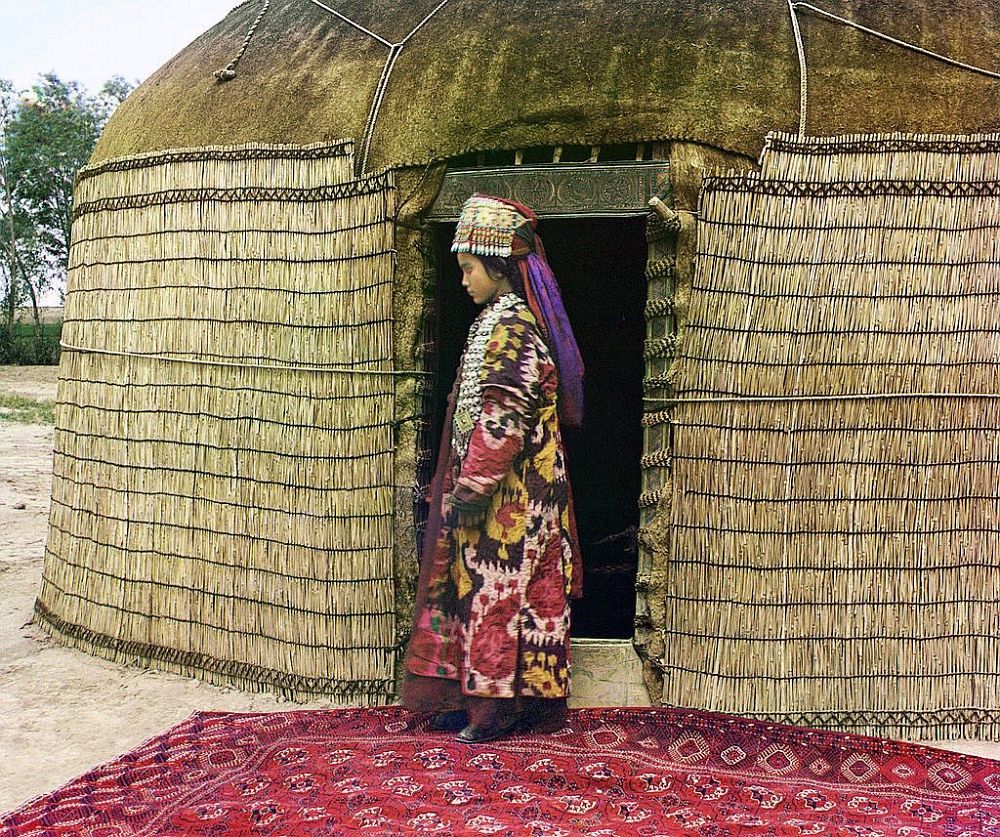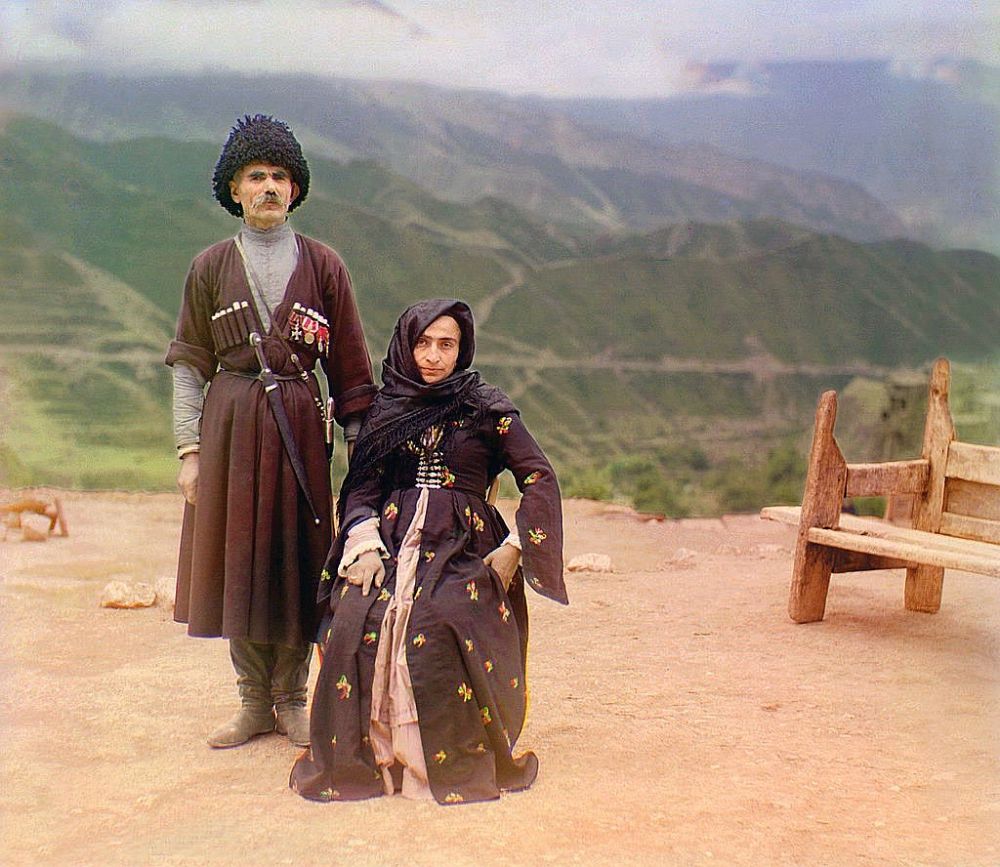Sergey Prokudin-Gorsky (1863–1944) became photographically renowned in Russia for a color portrait of Leo Tolstoy. It was this fame that, in 1909, brought him to the attention of Tsar Nicholas II.
Prokudin-Gorsky’s subsequent meeting with the tsar and the tsar’s family was to be the pivotal moment in his life: The tsar provided both the funding and the authority for Prokudin-Gorsky to carry out what he would later describe as his life’s work.
For most of the following decade, using a specially adapted railroad car as a darkroom, Prokudin-Gorsky traversed the length and breadth of the Russian Empire, recording what he saw in more than 10,000 full-color photographs.

The Emir of Bukhara, Alim Khan (1880-1944), poses solemnly for his portrait, taken in 1911 shortly after his accession. As ruler of an autonomous city-state in Islamic Central Asia, the Emir presided over the internal affairs of his emirate as absolute monarch, although since the mid-1800s Bukhara had been a vassal state of the Russian Empire. With the establishment of Soviet power in Bukhara in 1920, the Emir fled to Afghanistan where he died in 1944. Image: Prokudin-Gorskii / Library of Congress

A merchant at the Samarkand market displays silk, cotton and wool fabrics as well as a few traditional carpets. A framed page of the Koran hangs at the top of the stall. Image: Prokudin-Gorskii / Library of Congress

Prokudin-Gorksii captures the traditional dress, jewelry and hairstyle of an Uzbek woman standing on a richly decorated carpet at the entrance to a yurt, a portable tent used for housing by the nomadic peoples of Central Asia. After conquering Turkestan in the mid-1800s, the Russian government exerted strong pressure on the nomadic peoples to settle permanently in villages, towns and cities. Image: Prokudin-Gorskii / Library of Congress

Dressed in traditional Central Asian attire, a vendor of locally grown melons poses at his stand in the marketplace of Samarkand in present-day Uzbekistan. Image: Prokudin-Gorskii / Library of Congress>

Pinkhus Karlinskii, the supervisor of the Chernigov floodgate, stands by a ferry dock along the Mariinskii Canal system in the northern part of European Russia. In the photo album of his tour of the canal system, Prokudin-Gorskii noted that Karlinskii was 84 years old and had served for 66 years. Image: Prokudin-Gorskii / Library of Congress>

A Bashkir switch operator by the main line of the railroad, near the town of Ust-Katav on the Yuryuzan River between Ufa and Chelyabinsk in the Ural Mountains of European Russia. Image: Prokudin-Gorskii / Library of Congress>

Wearing traditional dress and headgear, a Turkmen camel driver poses with his camel, laden with what is most likely grain or cotton. Camel caravans remained the most common means of transporting food, raw materials and manufactured goods in Central Asia well into the railroad era. Image: Prokudin-Gorskii / Library of Congress>

A Chinese foreman poses with established tea plants and new plantings at a tea farm and processing plant in Chakva, a small town just north of Batumi on the Black Sea coast. Image: Prokudin-Gorskii / Library of Congress>

In a photograph taken near Samarkand, an elderly man, probably an ethnic Tajik, holds birds he has just caught . Samarkand and its region were noted for wide diversity in ethnic groups, including Uzbeks, Tajiks, Persians and Arabs as well as the more recently arrived Russians. Image: Prokudin-Gorskii / Library of Congress>

Dagestan, meaning “land of mountains” in the Turkic languages, contains a population consisting of many nationalities, including Avars, Lezgi, Noghay, Kumuck and Tabasarans. Pictured here is a Sunni Muslim man of undetermined nationality wearing traditional dress and headgear, with a sheathed dagger at his side. Image: Prokudin-Gorskii / Library of Congress>

A couple in traditional dress poses for a portrait in the mountainous interior region of Gunib on the north slope of the Caucasus Mountains in what is today the Dagestan Republic of the Russian Federation. Image: Prokudin-Gorskii / Library of Congress>

Young Russian peasant women offer berries to visitors to their izba, a traditional wooden house, in a rural area along the Sheksna River near the small town of Kirillov. Image: Prokudin-Gorskii / Library of Congress>

A. P. Kalganov poses with his son and granddaughter for a portrait in the industrial town of Zlatoust in the Ural Mountain region of Russia. The son and granddaughter are employed at the Zlatoust Arms Plant—a major supplier of armaments to the Russian military since the early 1800s. Image: Prokudin-Gorskii / Library of Congress>

Prokudin-Gorskii, right front, and others ride the Murmansk Railroad in a handcar along the shores of Lake Onega near Petrozavodsk. From the beginning of Russian railroad construction in the 1850s, rails were laid using a wider gauge (5 feet, 3.5 inches) than the standard European one. Image: Prokudin-Gorskii / Library of Congress>

Inmates stare out from a zindan, a traditional Central Asian prison — in essence a pit in the earth with a low structure built on top. The guard, with Russian rifle and bayonet, is attired in Russian-style uniform and boots. Image: Prokudin-Gorskii / Library of Congress>

Samarkand, an ancient commercial, intellectual, and spiritual center on the Silk Road from Europe to China, developed a remarkably diverse population, including Tajiks, Persians, Uzbeks, Arabs, Jews and Russians. Samarkand, and all of West Turkestan, was incorporated into the Russian Empire in the middle of the 19th century and has retained its ethnic diversity. Here, Jewish boys in traditional dress study with their teacher. Image: Prokudin-Gorskii / Library of Congress>

Many Central Asiatic peoples lived nomadic lives, migrating seasonally from one place to another as opportunities for obtaining food, water, and shelter changed. Shown here is a young Kazakh family in colorful traditional dress moving across the Golodnaia (or “Hungry”) steppe in present-day Uzbekistan and Kazakhstan. Image: Prokudin-Gorskii / Library of Congress>

Ethnic Russian settlers to the Mugan Steppe region established a small settlement named Grafovka, immediately north of the border with Persia. Settlement of Russians in non-European parts of the empire, and particularly in border regions, was encouraged by the government and accounts for much of the Russian migration to Siberia, the Far East and the Caucasus regions. Image: Prokudin-Gorskii / Library of Congress>

Workers, identified by Prokudin-Gorskii as Greeks, pose while harvesting tea from plants spreading over rolling hills near Chakva, on the east coast of the Black Sea. This region of the Russian Empire, in present day Ukraine, Moldova and Georgia, had a significant Greek minority. Image: Prokudin-Gorskii / Library of Congress>

Monks plant potatoes in fields reclaimed from the dense conifer forest at the Gethsemane Hermitage on Lake Seliger near the headwaters of the Volga River. Image: Prokudin-Gorskii / Library of Congress>

Workers and supervisors pause for a photograph amid preparations for pouring concrete foundations for a dam across the Oka River southeast of Moscow, near the small town of Dedinovo. Image: Prokudin-Gorskii / Library of Congress>

The Ural Mountain region is noted for the richness of its iron deposits and ores. The Bakaly hills, in the area outside the city of Ekaterinburg, provide the locale for a small-scale family mining operation. Image: Prokudin-Gorskii / Library of Congress>




